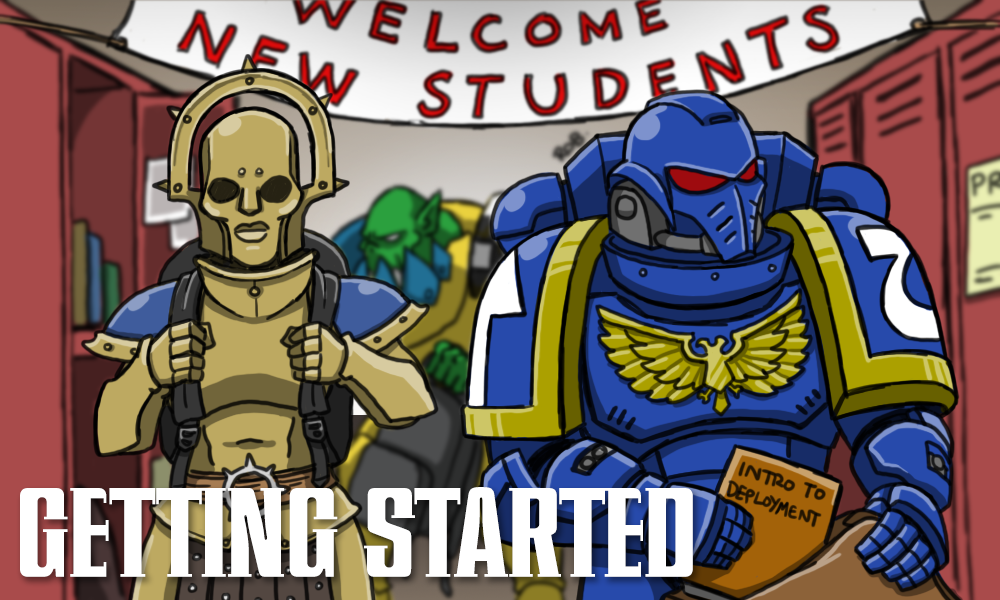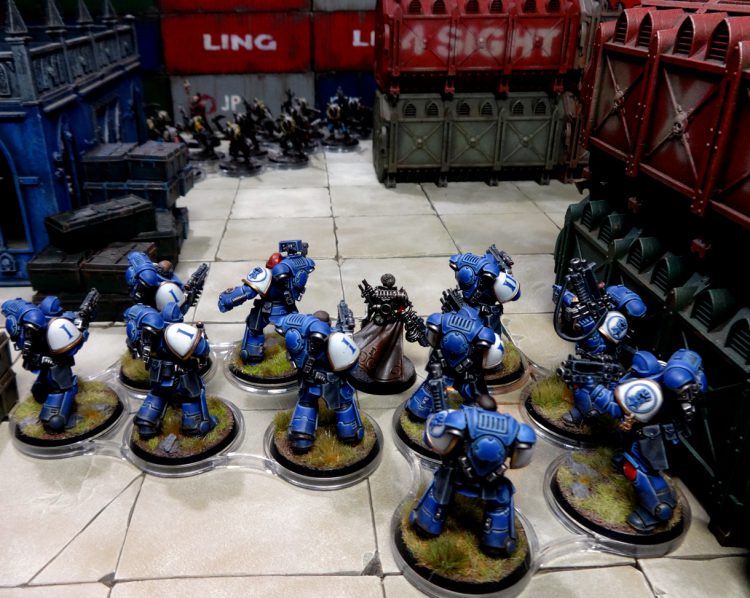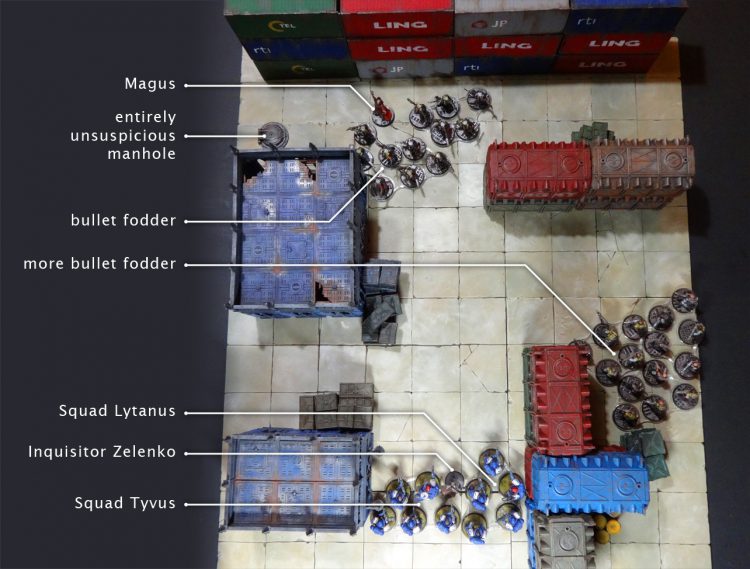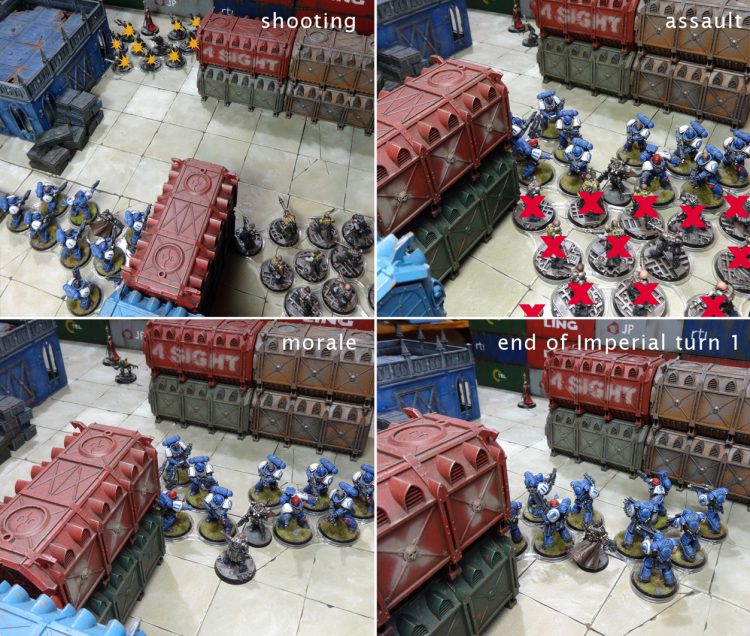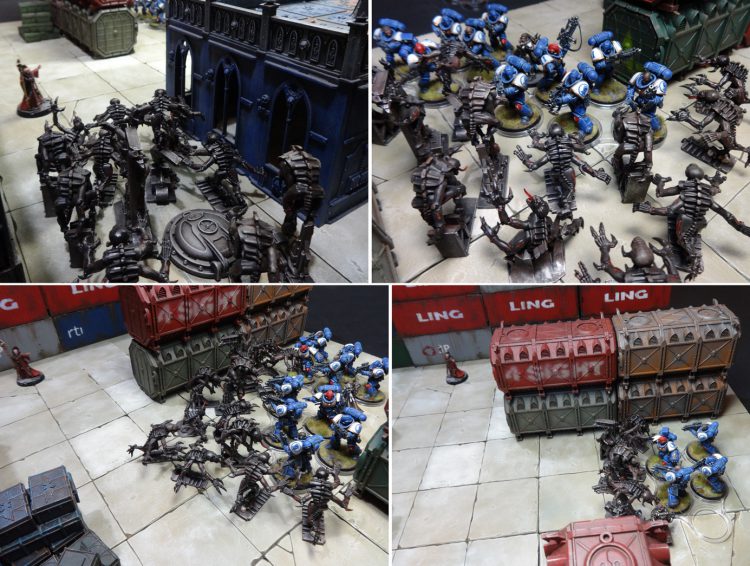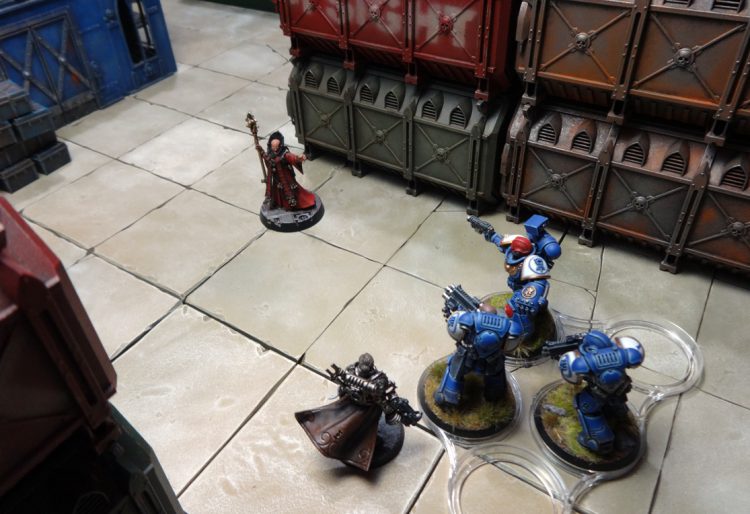Charlie: Like other mammals, Warhams need to reproduce. Unlike other mammals, we don’t have to use our reproductive organs. Instead, we use the time-tested hobby intro (although carriers of dormant hobby genes can also be pollinated by stray copies of White Dwarf).
Note that while we’ll be using specific games, miniatures, or ranges in our examples here, the methods we’re talking about are largely game-agnostic – we’ve attempted to create a guide to introducing new people to the games you love regardless of the game or format.
Along for the ride is Neon, who will be offering additional commentary. Like me, Neon is a one-time GW retail staffer and has thus shepherded many new nerds into the fold in their time. Of course today we’re not talking about running intros in a shop, but moreso in a laid back social context with people you know personally.
Table of Contents
General principles everyone should use
The golden rule: listen
This is probably the single most important piece of advice, so it’s right here at the start. If someone is showing an interest in your shelves of wee soldiers, don’t start waffling at them. Ask them which ones they like, and why. Ask them if they’d like to know more, but not in an overly keen Johnny Rico kind of way. You should ensure they should feel able to step away from the conversation, while also knowing that you’re happy to talk about it as long as they’re interested.
There’s so much to say about the hobby that it can be tempting to start lecturing them, but people’s attention span is much better if you let them lead the conversation. An example: my friends Becs and Drew were hanging out one night after a TTRPG session and asked about an offhand comment I made about the horror influences in the 40K setting (Becs is a big horror fan). I pulled out an artbook and handed it to them to leaf through, and answered their questions when they came to characters and images that interested them. This put them in charge of the pace and the conversation. I figured it’d be fifteen minutes and then they’d head home, but after grilling me for several hours, and through several more books, they were both excited about the setting. We’d played no games and painted no miniatures, but the seed had been planted.
Neon: One thing that absolutely infuriated me when I was trying to introduce fresh-faced people into the hobby was nerds pouncing upon them to vomit up half-remembered Lexicanum slurry. Just absolutely insatiable in the pursuit of showing off how much fanon they’d crammed into their smooth as a bowling ball brains. Different people are gonna come to the hobby for different reasons, talking over those reasons so you can parrot off Text-to-Speech bits is a sure-fire way to turn off almost everyone that shows interest. Listen, and try to tease out what caught their eye in the first place.
Be mindful of your own insecurities and assumptions
It’s amazing how much one’s own personal baggage can lead to assumptions about other people. It took me a while to notice I’d make self-deprecating jokes about my hobby because I was assuming people would find it dorky, when in reality, those people wanted to know how they could get involved. Their hesitance wasn’t about disinterest. To my surprise, it was actually because they were intimidated. Adults in particular are not used to learning new stuff all the time like kids do, and have become more scared of being bad at things. Adults will often think there’s no way they could paint something as well as you, even if you know how much you suck compared to whoever’s godlike work most recently humbled you on Instagram.
In short, be wary of the things you think you know about the person you’re talking to. Ask yourself how many of those things you have real evidence for, and how many of them you’ve come to because “oh, that guy’s dressed like a jock so he’s clearly faking an interest in my Space Marines,” or “she’s really into video games, so there’s no way she’ll be into something as slow-paced as painting.”
Neon: One of the main things I really, really genuinely miss about working in a game store is just the sheer variety of people who came in. Not just the obvious nerds and crusty milhistory dads, but people from every sort of walk of life and subculture and background you could think of. Some of my favourite customers were a set of nigh-permanently stoned skaters, seemingly transplanted straight from the dark age of the 90’s, who despite the misgivings I saw other staffers give them, were some of the most enthusiastic and interested hobbyists I’ve ever met.
Be patient, be polite and be willing to field any and all questions.
How do you differ?
The things in the hobby which excite you won’t necessarily be the same things that excite them. They might be less interested in competitive play. They might be super stoked about converting minis but have limited interest in painting. If you think their preferences are identical to your own, honestly ask yourself how you know that.
Watch your lingo
Almost everyone uses lingo without realising, and people are often too polite or nervous to say they don’t understand. Phrases like ‘local meta,’ ‘ballistic skill,’ ‘troops choice’ and ‘board control’ hold no meaning to the uninitiated. Choose your words carefully!
Neon: Moreso than in-game lingo and terminology from my experience, watch your memes and nicknames. When we’re around other people embedded in a fandom, we tend to communicate in a patois of in-jokes and memespeak. Hell, even within fandoms this can lead to confusion, around the Goonhammer offices we tend to use Ham as a shorthand for anything from Warhammer itself to any wargame mini and that hasn’t particularly caught on in the wider Wargaming culture (yet, yet). People fresh to hobbying in particular are gonna have zero, nada frame of reference for your super insightful Spiritual Heirs reference, so just dump that out of your brain and explain yourself.
Keep it casual, keep it plain, keep it understandable.
Be inclusive
This is really about assumptions again. When a particular demographic forms the overwhelming majority in any given hobby/sport/whatever, human pattern recognition kicks in, and people start assuming that people from other demographics won’t be interested. This then becomes a circular, self-fulfilling prophecy. My friend Drew has gone into her FLGS with her boyfriend on a number of occasions, and they’ve immediately asked him what he’s come in for.
Drew’s boyfriend couldn’t be less interested in miniatures.
When you’re introducing someone to the hobby, particularly if it involves a product range where the diversity still has a way to go (i.e. most of them, unfortunately) it may be worth emphasising the direction of travel. GW in particular seem to have turned a corner on this in recent years, and it’s only going to get better. It’s a welcome contrast to the time I saw a mother drag her clearly fascinated daughter out of my store while saying, and I quote, “don’t worry darling, I’ll take you home and show you some nice sewing.”
Neon: Don’t be a prick. Like seriously it’s not hard. I cannot count the amount of women who started enthusiastically coming down to game nights and painting sessions in store, only to slowly trail off into only ever hobbying at home due to the shitty little comments and actions of gross nerds. Gatekeeping on the basis of someone’s identity sucks ass and you should consider Getting in The Sea if you think it’s good, akchually.
As part of that, challenge stupid assumptions like the one Charlie mentioned above when you can. Even if it doesn’t convince the person you’re challenging, (which lets be honest it most likely won’t, we don’t live in some dumb smug show like West Wing where a snarky quip instantly changes someone’s worldview), it can do wonders to help encourage whoever the offending party is trying to press down.
Okay, hopefully that’s covered the pitfalls of making assumptions based on one’s own bullshit and society’s bullshit. Onwards!

Running intros for New Hobbyists
Introduce ALL elements of the hobby
At this point neither you nor they know what they enjoy most out of building, painting, or playing. If they do have a strong preference up front, then feel free to skip bits, but often people will be saying no to painting because they think they’ll suck, and you get to surprise them. By default I’d show them (depending on time constraints) how to build and paint a mini, then play a game. Those don’t all have to be with the same mini, but it helps. Obviously, the simpler the mini the better!
Neon: Games Workshop really has their intro system refined to an art form at this point, and there’s a reason a big part of their interview process for new staffers is making you run a demo of a simplistic game. (If you’ve ever suffered from having to play a round of Powder Monkey, you’ll know). There’s a reason we’re basing this outline on what they drill you to do.

Introducing people to building & painting
Fish something out of your pile of shame. Make it clear to your friend that you don’t mind what happens to this particular mini! In a perfect world it’ll be something that’ll look good if subjected to easily teachable techniques like drybrushing. I love basic Night Goblins for this because they’re not overly busy, but they have some fun details and a variety of materials. Also they’re adorable. Here’s the two goblins Drew and Becs painted:

There was some uncertainty at the start, but as the finishing touches started to go on, like their wee pink noses, glee abounded. As did surprise. They were expecting a total mess, but I’d stuck to techniques that were easier to follow. Here are some pointers on this bit of the process:
- If you can, pick a mini you have several copies of, and paint one alongside your friend so you can demonstrate a technique without risking painting the model for them, which is no fun for anyone.
- Try not to touch their mini at all; you really want them to know that this is their work.
- Provide encouragement through the tricky bits. Strike a balance between calling out the stuff they’re doing a good job of, and avoid laying it on so thick that it’s patronising.
- Give them some choice about which colours to do some bits (“would you like the moon on the shield to be yellow, red or blue?”) but just give them a process to follow for other bits. Their brain is being bombarded with new information, so being asked to make too many decisions at the same time can be a bit relentless.
- Avoid techniques like highlighting or layering. They require a whole bunch of brush control and will make the model look worse if done poorly. Getting good, neat basecoats followed by a spot of drybrushing and a shade or two will be perfect for de-mystifying the basics of mini painting.
- Keep track of time. You want to get a finished mini out of this to give your friend the satisfaction of making a complete thing, so if they have to leave at X o’clock, plan accordingly. You probably want to have the thing painted within an hour. Shop staff will generally try and get it done in 10-20 minutes, but that’s just about practicality – you don’t have to rush as much with a friend in your own home!
Playing the first game
There’s all sorts of ways you can go about running an introductory game, and your choice should be determined by knowing what sort of thing your friend will find interesting. I’ve broken the options down into some broad brushstrokes below, but whichever you choose, always finish your introductory spiel by giving them a clear objective (e.g. hold this bridge until the end of the game, kill that wizard, get to the escape pod, whatever).
Game type 1: narrative emphasis
If they’ve played tabletop RPGs like D&D, then a narrative heavy approach might feel familiar and engaging. In this approach you’ll be narrating the game much like a GM would in a TTRPG, setting the scene and then asking the player to make characterful decisions.
Neon: You’re functionally GMing for your intro-ee’s, so lean into it and have some fun. Both intro boards at our store had a simple lil’ backstory and names for the main commanders to lend context to what’s happening in game, just little details like that can lend some good texture to the experience. Even if the game goes horribly, horribly wrong for your subject you can play it up as the joy of emergent storytelling. We’ll go into this a bit more down below.
Game type 2: tactical emphasis
If your friend is really into strategy and isn’t particularly excited by the narrative elements, then focus on setting up an encounter that demonstrates how the gameplay creates interesting tactical decisions. Normally in an intro I’d avoid being particularly specific about the rules, but someone with this mindset will smell the vagueness and find that frustrating. Don’t try and teach them the whole rules, just come up with a situation that provides a few interesting conundrums.
Game type 3: beerhammer
Some people just want to throw some dice and laugh as stuff gets blown up, and if this is the case, just get stuck in. They might find you narrating a scene a bit fussy and awkward, so keep it down to the broadest brushstrokes, almost to the extent of, “here’s some futuristic fascist space monks wearing powered armour, and here’s some alien monsters with blades for hands. Which ones do you want to be?” …and just get the dice rolling, preferably with a turn one charge.
Game type 4: the perfect blend
Some people – I would argue the ones likely to enjoy the hobby the most – want all of the above to some extent. This gives you the opportunity to run what I think is the most fun type of intro game: one where you set a scene, introduce some characters, make the player feel like they’re there, give them some tactical decisions – where they understand the consequences – and then get some dice rolling. Fast.
This is the most challenging form of intro to run, because it requires you to be a good storyteller, be good at explaining a tactical conundrum in simple, jargon-free terms, and to do all of the above very quickly so you get them rolling a handful of dice with some quick, violent action on the tabletop.
Don’t worry if you don’t feel you can do all this perfectly. Even doing a sort-of-okay rendition will probably allow the minis and the game to shine through, and hopefully, your friend will walk away curious and excited to get deeper into this weird world of toy soldiers and ultraviolence.
Since this is the trickiest (and I think, hands down best) introduction, an example of one is provided below.

Sample Intro Game for Warhammer 40,000
In this hypothetical example my friend Wilhelmina Crunkspewter, allegedly visiting my residence for a sophisticated chat about magic realism in Peruvian literature or something, has seen my nerd cabinets and has declared that Space Marines are the coolest thing she’s ever seen. She has thus imperiously demanded to see them in action. I am assuming you have 30-40 minutes you’re willing to spend on trying out Warhammer 40,000. Again, this is longer than you’d get in a shop, since I’m assuming there’s less of a rush.
Note: the following example game is absurdly specific
This is deliberate. The intention is not for you to slavishly mimic my example, but to think about how and why it works as an intro, and then think about how you could create a fun intro using your own collection.
Provide some context & set the scene
Underneath is 90 seconds of narration that sets up the setting and the situation. This probably represents the maximum amount of preamble you can get away with!
It’s the far future, and everything’s comically awful. Today, you’re playing as Inquisitor Nadiya Zelenko. She’s an agent working for the Imperium: the crumbling fascist dystopia staving off humanity’s extinction.
You’ve come to the industrial world of Meridia Secundus. There’s a rebellion underway, but you think there’s more to it than meets the eye. Maybe alien influence, maybe demon-worshipping cultists.
Sniffing around for clues, you learn that one of the stockyards used to supply the Imperial armies has stopped shipping its goods, and the platoon of soldiers that were sent in to investigate never returned. You decide to investigate yourself, and being an Inquisitor, you are authorised to requisition whatever forces you deem appropriate.
Rather than taking normal soldiers, you are bringing two squads of humanity’s finest creations: nine-foot posthuman Space Marines. You have learned their leaders are named Sergeant Tyvus and Sergeant Lytanus. Between them, and your own psychic abilities, you are confident in your ability to handle any rebel scum you encounter.
The stockyards are over a mile across, shipping containers fading into the mist. In the distance ahead you can see the towering silhouettes of habitation stacks. Behind you, the low rumble of the docks.
Once you’re deep in the stockyard, far from reinforcement, you see shapes emerging from the mist. They’re dressed as civilians, but as they get closer, you see there is something seriously wrong with them. Glistening, bulbous heads. Claws instead of hands. And they’re well armed. Striding behind them, smiling calmly, is a figure wearing strange robes. You sense the taint of raw psychic power in him, and your objective becomes clear: kill him, and anything that gets in your way.
Stratagems?
I suggest you don’t use stratagems in a game for new hobbyists. If however you are keen to introduce what is unarguably a significant part of the gameplay experience, one way to do it would be to pick three basic ones (re-roll, overwatch, that sort of thing) and treat them like single use cards they can play when desired.
Neon: Really don’t recommend you use Strats outside of re-roll and Overwatch, even in a more Strategy orientated introduction. Give players maybe 3 CP each and tell them it’s just for re-rolls and Overwatch if you bother at all.
The battlefield
For an intro you really only want about a 2’x2’ playing area; the terrain in this scenario has been carefully distanced to control the possibilities in the opening turn while also minimizing complex terrain rules.
The forces
You want to keep things small. For a game like 40K this is a tiny force, but still twice the size of, say, Kill Team or Necromunda.
Neon: Obviously the small and mid-sized intro boxes are a good guideline for this kinda thing. If you’re inclined, letting players pick a selection of units from said intro boxes can be a fun way to emphasise player expression. Generally in store we aimed for something along the lines of the Start Collecting structure of an HQ, a Troops and one extra unit (ignoring vehicles, bar maybe light ones like the Blight Drone).
Start the action
Give the player turn one. Have a group in plain site to shoot at, and a group around some terrain that the marines can charge, as shown below:
Movement
Tell the player the first thing to do in their turn is to move their miniatures, and that they can all go 6 inches. I’ve put the squads on movement trays so that I don’t have to explain unit coherency. Tell the player they could stay still if desired, but in this situation, advancing will give them a chance to charge at the hidden foes and get the drop on them.
Mind bullets o’clock
Keep things simple; just use smite. Have Inquisitor Greyf… err… Zelenko melt some poor schmuck.
Fire everything!
Start the shooting off with the Inquisitor to show how shooting works. Don’t bother measuring any ranges; everything’s pretty close anyway. She’s got a bolter, so she gets two dice. She needs to aim first, and needs 3 or more to succeed. Next, find out how badly hurt the cultists are: on a 3 or more, they’re dead. That’s right, I’ve skipped the armour saves since they’ll probably fail anyway.
Narrate how the marines take the Inquisitor’s shots as their cue to open fire. Point out the little underslung grenade launchers on the marines. To save narration time, just roll the shots for both units simultaneously.
Have the grenade launchers fire first to start with an actual bang; ask her if she’d like to use anti-personnel or anti-tank grenades to give an impression of how guns can have different roles.
Next, increase the dice volume by moving on to the bolt rifles. Explain that each dude firing a rifle gets two dice, and that this is just like what she already did with the Inquisitor, but on a bigger scale. Give a quick description of the effect of the bolt rounds on the cultists: limbs blown off, bodies ruptured, shock and dismay on their faces.
Then check if she wants to follow up this initial volley by charging into hand-to-hand combat.
The assault
Skip this section if she chose not to charge, obviously. Since you’re charging around the corner, overwatch definitely won’t be a thing. Make the charge rolls as normal.
Assuming anyone gets into melee (and most of them should, given the distances), explain that each marine gets three dice (they don’t need to know about Shock Assault, or indeed, most actual rules). Resolve the damage, but this time introduce the concept of the enemy getting an actual save since punches aren’t as lethal as bolter shots.
With the basic marines resolved, move on to the sergeants and the Inquisitor. Describe the cracking discharge of the power fist’s energy field, and the way the shimmering blue power swords of Sergeant Lytanus and Inquisitor Zelenko light up the sides of the shipping containers, leaving glowing gouges in their foes. Don’t go into more detail than that, just little snippets to bring it to life. Keeping the pace up is important, and it’s easy to get lost in overly described details.
If any cultists survive, resolve their attacks.
Morale
Having reached the end of the turn it’s time to see whether the enemy start fleeing from the Imperium’s brutal assault. Just take the dice rolls and, if people flee, narrate them running off in terror, clearly taking no further part in the fight.
The Empire is Struck Back
At this point it might look like Inquisitor Zelenko has all but won, but of course in reality it’s a trap. The manhole cover springs open, and purestrain genestealers come flooding out! Describe their movements as they skitter up the sides of shipping containers, their claws cutting straight through the metal, to help build up the sense of threat as they approach the marines. Don’t forget to advance with them to really convey their speed.
The Magus Smiles
Have the Magus attempt to cast Mind Control on the Inquisitor. Describe the throbbing sense of a greater gestalt consciousness flowing through the Magus as he attempts to breach Zelenko’s mental defences. Assuming he cast (and you probably want to say he succeeded even if he rolled too low, unless you get snake eyes or whatever), give Zelenko a chance to deny the witch. Describe Zelenko barely suppressing the urge to fire her bolter at one of the marines; essentially, try to get Wilhelmina invested in taking this bastard out.
Incoming fire!
Resolve whatever ranged weapons the cultists still have in play (if there are any left), but this time, don’t skip the marines’ armour saves!
The Genestealers charge
Let everyone fire Overwatch even though that’s not normally a thing; give a sense of it being that last-ditch effort to thin their numbers before the inevitable. Don’t skip the genestealers’ 5++. Have the stealers attempt to charge both units of marines, and give Inquisitor Zelenko a chance to intervene, but emphasise the pros and cons of doing so – make it a tense decision about whether to try and save your men or spend them like pawns so she’ll be free to get after the Magus (i.e. the objective) in her turn!
The stealers will probably maul the squad they hit. Quietly ignore the morale phase, since none of these units are likely to fail anyway.
Imperial Turn Two: conundrum
Give Wilhelmina the choice if she’s engaged by the stealers: withdraw or stay in the melee. Explain that normally withdrawal would mean you can’t do much else that turn, but the marines have a faction special rule that lets them attempt some shooting even after falling back. If she falls back, emphasise the importance of the movement phase in determining who is going to be on the receiving end of the Inquisitor’s smite.
Play the rest of the ****ing owl, and end well
This game should be over by the end of battle round 3, if not sooner. If she wipes out the Purestrains, the Magus is the final boss; if she wipes the Magus, the Purestrains are the final boss. You get the idea. The important thing is that the Imperial force is left battered but victorious.
If the Magus is the last to die, end the game with the Magus whispering “she’s here, father, ready to join the family,” after which Inquisitor Zelenko feels a distant psychic presence reaching out for her mind, leaving her with the feeling that an apex predator has her scent.
If the Purestrains are the last to die, have Lytanus or Tyvus inform the Inquisitor that his auspex is detecting bio signatures converging on their position from multiple directions, and fast. Either way, ending the game with a thematic 40K “you’re almost certainly doomed… almost…” and, hopefully, leave Wilhelmina wanting more. Of course it’s possible that the ‘stealers will have a great run of it, in which case, make it feel more like a horror movie and have Zelenko send one last emergency transmission to warn others of the danger.
Running Intros for established hobbyists
A big difference here is that you won’t need to give them an intro to painting at all; just show them the product range to see if the designs appeal. The main difference with the game itself is that I would go into more detail about how the game actually works, since an established hobbyist will be more curious about how it differs to the things they’re used to, but otherwise, something like the example game above would still be fine.
Depending on the person, they may even want to dive into a fully fledged game of the system in question, although I’d proceed with caution there and, obviously, stick to smaller points sizes. I’ve seen lots of people tell their friends they need 2,000 points of stuff to play 40K properly and it’s just not true, particularly in 9th edition with its scenarios specifically aimed at a range of game sizes. The hobby is way more accessible if you understand it’s fine to work towards small milestones, playing games along the way.
Neon: A big unfortunate hobby memory in my mind was trying to get into Warmachine back during the dark days of 6th edition 40k. I rocked up to a games club with an intro box army and asked politely if anyone had the time to teach me the basics. Upon finally finding someone, they proceeded to do not just a shit job of teaching the rules, but kicked my ass up and down the table in minutes before smugly boasting about what an easy win it was to the rest of their buddies.
Obviously, this was an extreme case, but it gives us a good example of what very much not to do, even to an established hobbyist. A hobby can only grow if people are willing to lay off the gas and teach interested people the ropes. Beating someone without threat of any difficulty, then laying on your biggest shit eating grin as you relish saying “Not really lol” when they ask you what they could have done better is absolutely not the way to go.
Running intros for multiple hobbyists
There might be an instinct to put players on opposing sides. After all, that’s how it normally works. However, I personally find it easier to give each player command of an individual unit and let them figure it out as a team. This gives you more room for fudge factor, say if you need to suddenly introduce extra enemies or whatnot.
Something else to look out for, particularly during the painting, is that some people unwittingly demand more attention than others. You don’t have to give everyone perfectly allocated amounts of love, but do make sure quiet people aren’t unhappily sidelined.
Neon: For younger prospective Hams, group games can often be the way to go if you get the opportunity. Letting kids split a single side’s units between them while you control the opposing side can lead to a lot more interesting games than pitting them against each other, where from experience they tend to lean on your approval for any move they make, and can spark unfortunately graceless competitive tendencies from more outgoing younglings. Besides that, it’s a near immutable force of the universe that says any game is better played with friends, so you might well take advantage of it!
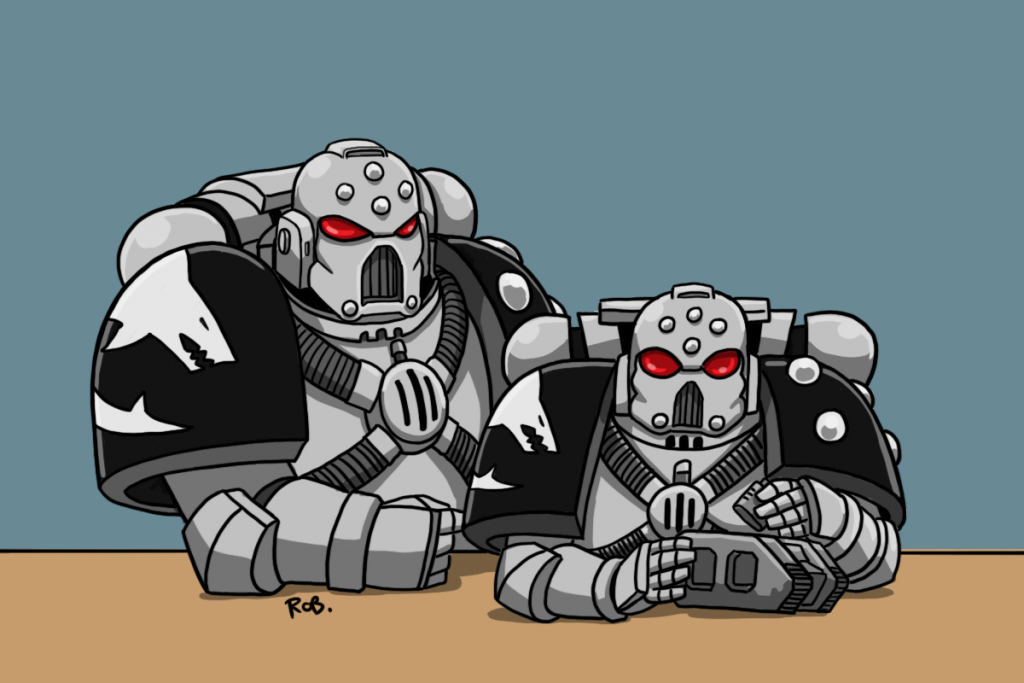
Nurturing Your Ham Children
They’ve made their first purchase… now what?
My first port of call here is to suggest a hobby hangout; get together and shoot the shit while building and painting stuff. It’s a civilised way to spend an afternoon, and will help them avoid that scary feeling of looking at their first assembly manual, since they can just ask you for however much advice they want.
Depending on their preferences, you might start playing games using your finished minis, or their unpainted ones, building an understanding of how the game works while working towards a more complete warband/army/whatever. In the case of our running case study (Becs and Drew) they split a Deathwatch box and painted up some marines for a roleplay scenario a group of us played. We got together one Sunday afternoon and I talked them through the painting process. Behold, the second miniature either of them painted. As you can see, they were improving quickly.
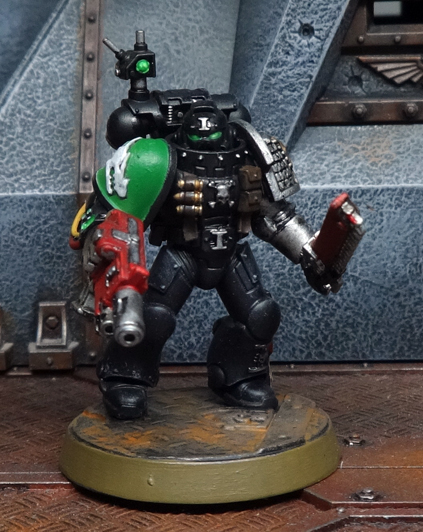

The pitfalls
With you being the expert and them being the noob, there are risks. One is that they feel obligated to just do whatever you say is best, and that’s absolute poison for hobby joy. Try to ensure you’re helping them pursue the stuff that excites them. If they say “I really want to paint a baneblade,” it’s very easy to say “well actually you can’t use that in smaller games, so you should build X, Y and Z first.” That’s technically accurate advice, but there’s better ways of delivering it, e.g. “go for it, it’s a beautiful model. Do you want to do any practice tanks first, or do you want to jump right in? I guess if it goes wrong you could always do another further down the line. Game-wise it’s a unit designed to work as part of a larger army, but I’d be up for a few skirmish scenarios where it’s your baneblade versus a squadron of my smaller tanks.”
A key thing here is that, much like raising actual kids, you have to let them make their own mistakes on occasion, and you have to accept that they don’t have to – and probably won’t – follow all your advice. You’re there to answer questions and offer guidance, not to issue edicts.
Another key thing is to let people go at their own pace. They might need weeks or even months to come around to the idea of painting wee plastic dudes. If they’re genuinely interested, they’ll get to it. Nagging people usually makes them back off; suggesting a hobby hangout or a game day usually eggs them on.
Neon: Play it cool. If you nurture that initial spark, don’t proceed to smother it out by piling on. Ask them where they want to go from here and nudge them along in the right direction when they choose. I cannot count the amount of games I’ve had my interest in doused out quick by over-enthusiastic/over-eager friends attempting to throw me in at the deep end after dipping a toe.
To paint or not to paint?
I know a great many hobbyists game with unpainted stuff, and that’s entirely fine, but what I’ve found is that when people play games – even small ones – with fully painted armies and terrain, the experience leaves them a lot more pumped up. In our gaming group we pretty much only play with finished minis, and I always tell new people they’re welcome to use unfinished stuff, but that I am also happy to lower our points level down to the stuff they have finished. If they do want to have some games with unfinished minis, then seeing their minis being the only grey plastic seems to encourage people to up their hobby without my having to nag them at all! So don’t set the rules, set an example. Ugh, that’s saccharine. But it’s true.
Neon: If you find the situation of your Ham neophyte not enjoying painting, but wants to have finished models, consider offering alternative methods of painting. Games Workshop pushes the Citadel system and ‘Eavy Metal, but they don’t always click with a person. Contrasts are a good alternative, as while GW seem to have themselves laid off from it being a whole alternative method in itself, they do good work at getting presentable models on the table. For older gamers, maybe consider techniques like oil washing or the like. Just, y’know, don’t immediately start badgering them to buy an airbrush or something that big an investment.
You’re not the only expert
There are all kinds of resources online, and (presumably) within your gaming group. Point them out, and before you know it, they’ll have disappeared down rabbit holes of their own choosing. Just maybe also warn them if they’re unwittingly checking out stuff you know to be… less useful or even harmful to the uninitiated. I once had a friend recommend a particular website to a new player because he found it amusing, but he hadn’t considered whether it was in any way comprehensible to the uninitiated. Worse, it was steeped in the kind of internet culture that gives internet culture a bad name, which doesn’t exactly inspire confidence in new hobbyists getting their first impressions of the community.
Try multiple games
Just because you introduced someone to 40K doesn’t mean it’s the perfect wargame for them. They might actually prefer Adeptus Titanicus, or Frostgrave, or Infinity, or AoS, or historics. Hopefully you’ll find one or more games that both of you adore, and generally I find having a little variety keeps things moving along nicely. Not too much, mind… that way lies a crippling lack of focus and a poorer return on your time and money.
Neon: A big, big pitfall I’ve seen many times is players attempting to jump into too many games at once, or even too many factions/armies in a single game at once. From experience, I’ve had many people, and especially friends with neurodivergent conditions like ADHD, attempt to go all in far too fast and hard and burn out of the hobby quick. If you can see the beginnings of this forming, be empathetic and try to rein them back in with gentle advice.
How best to learn the rules?
There’s an impulse to set up a game and talk your buddy through it. Weirdly, I’ve found it’s actually more effective to set up a game and have THEM talk YOU through it, particularly if the rules are well laid out. Show them the rulebook and their codex, show them how to look up the things they need, then let them work through a turn at their own speed. This means you tackle things like a unit’s stats when you get to the relevant moment in the turn, rather than doing a long introductory spiel. You can help clarify things if they get confused, but this method avoids disorientation. All you need is patience, since you’re about to play verrrrrrry slowwwwly. Overall, though, they’ll learn a LOT faster.
While they’re at the helm of the rules, you should focus on other ways to improve the game. Having got them powerfully jazzed with a cinematic intro game, it’ll be disappointing if every game after that is just staring at data cards and rolling dice. Look for ways to keep bringing the game to life, whether that’s talking about how you imagine their army would look as it moves across the battlefield, or making decisions with your own army that are rooted more in character than tactical brilliance. After all, being competitive in this context is, at best, pointless.
Noob Escalation
As your friend grows their collection, slowly increase the size of the games you play and introduce new challenges to them piecemeal. The first time they use or fight a tank should be exciting! Don’t rush to 2,000 point tournament lists; play combat patrols and slowly build, introducing new unit types as you go.
Be each other’s GM
With time, your relationship should slowly change from mentor to collaborator. You know what’s in their collection, so when picking your own units, choose things which will give them an interesting challenge. Effectively you’re balancing the encounter. It would be easy to win, but that isn’t what you’re trying to achieve. Your highest priority – if you want to keep your new gaming buddy – is to ensure your opponent is enjoying their game. That won’t happen if you treat every game like an opportunity to curb stomp a baby seal, or if you go so easy on them that they smash you in two turns.
This is something I do with all my games. I know my friends’ collections well enough that I could spec out my army to ruin them, but even if you’re a keen tournament player, you don’t improve by tailoring your list to beat one specific person’s army.
Taking this approach also helps your opponent – particularly if they’re a younger gamer – understand the collaborative nature of a wargame.
Does this really work?
Universal success is not guaranteed, but certainly, it’s worked on a number of my friends. Step one: they see my cabinets of painted stuff and get curious. Step two: I ask if they’d like to try it. Step three: moar nerds. Case in point, my aforementioned friend Drew is now approaching 2,000 points of fully painted Craftworlders. If you’re curious to hear about her hobby journey, you can read an interview with her and Becs about how I used tabletop roleplaying games as a gateway drug, and another interview with her about her Aeldari army, and her newbie perspective of 9th ed 40K. As a measure of success, Drew’s initial force is shown below. She’s since added more troops, wraith constructs, and a wave serpent.

Neon: Ultimately, a fanbase can only survive if it’s willing to reach out and invite people in, with a warm and friendly guiding hand. Especially in such a niche hobby like ours. I’m making it sound rather sombre and serious, but wargaming already has enough hurdles to appeal to people who’d otherwise adore it without our idiot nerd asses making it all the more difficult. Be polite, be empathetic, just be cool and good.
Hopefully this has left you feeling better equipped to introduce your own friends to our gloriously involved hobby. We’re not averse to updating/amending this guide over time, so if you have questions, or excellent methods of your own, please share them in the comments below and/or email contact@goonhammer.com.
